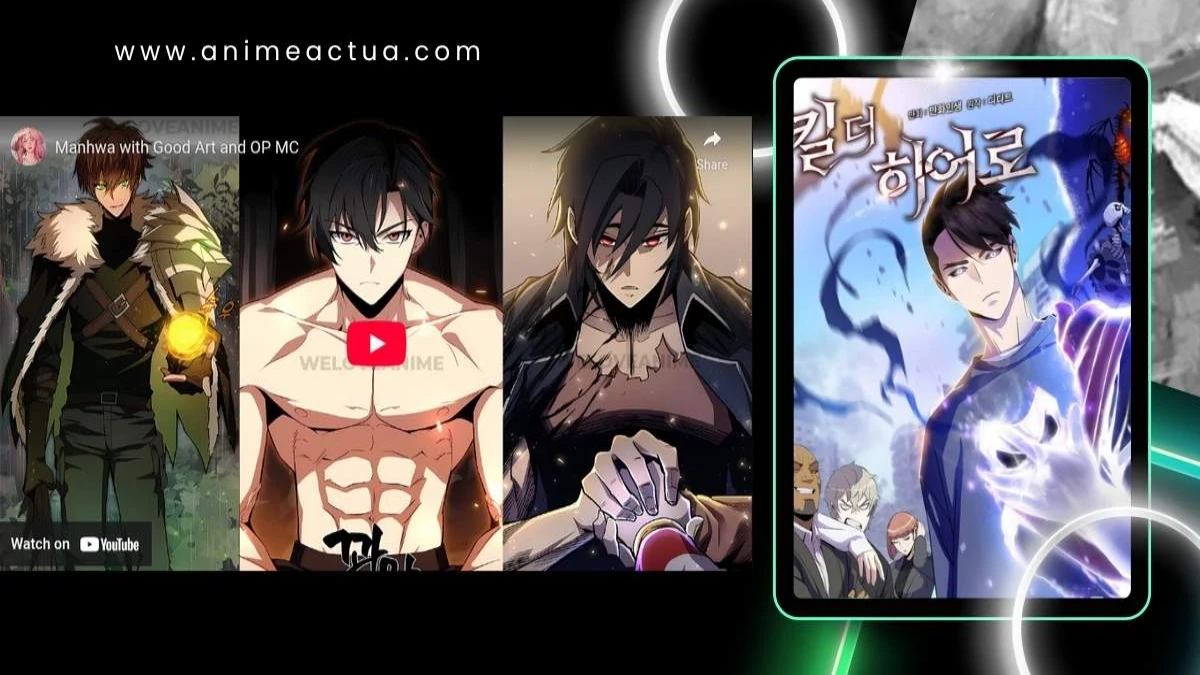The Art of Action Manhwa: A Visual Guide
Watch: The Art of Action Manhwa Explained!
Dive into the visual techniques and innovations that define manhwa’s unique art style.
Introduction
The Action Manhwa Art Style stands out in the fast-growing world of digital comics for its breathtaking visuals, dynamic movement, and cinematic storytelling. Whether it’s a bone-crunching martial arts showdown or a magical duel on the brink of reality, this visual style is more than eye candy—it’s the engine that drives emotion, pacing, and immersion.
This visual guide explores the techniques, trends, and innovations that define manhwa’s art, and why it’s capturing the imaginations of readers around the globe. For a broader understanding of webtoons, check out this Wikipedia article on Webtoons.
1. Full-Color Experience in Action Manhwa Art Style
Unlike traditional manga, most modern manhwa—especially webtoons—are presented in full color. This is a defining characteristic of this art style.
📌 Why It Matters:
- Emotional depth: Color palettes change based on mood (e.g., cool blues for suspense, warm reds for rage).
- Visual clarity: Backgrounds, effects, and characters are easier to distinguish.
- Modern appeal: Younger digital-native audiences expect vibrant visuals.
🖌 Example:
In Solo Leveling, red-tinted shadows signify danger and tension, while glowing blue effects highlight magical power-ups. This exemplifies the use of color in this art style. Learn more about color theory in design.
2. Vertical Scroll Format and Action Manhwa Art Style
Action manhwa are typically published as webtoons, which are designed to be read by scrolling vertically on phones or tablets. This format heavily influences its visual approach.
🌀 How It Impacts Art:
- Pacing control: Space between panels builds suspense and controls rhythm.
- Impact scenes: A full-screen panel or a long vertical slash can create a jaw-dropping moment.
- Immersion: Readers feel like they’re inside a cinematic sequence rather than flipping a page.
🖼 Visual Trick:
Long vertical panels are often used for falling scenes, tower climbs, or sky battles—adding scale and depth, a common technique in this visual approach. Explore more about WEBTOON platform.
3. Fluid Motion and Choreography in Action Manhwa Art Style
Combat in action manhwa often resembles animated fight scenes, with attention to detail in every kick, dodge, or energy blast. This dynamic approach is central to manhwa’s art.
🎯 Key Techniques:
- Motion blur: Adds speed and direction to attacks.
- Afterimages: Suggest rapid movement or teleportation.
- Split panels: Show multiple actions in a single second of time.
💥 Example:
In The God of High School, martial arts choreography mimics real-world techniques like taekwondo and muay thai—with fluid transitions between stances and hits. This illustrates the motion-focused visuals of the genre. Discover more about fight choreography.
4. Expressive Character Design in Action Manhwa Art Style
Characters in action manhwa aren’t just designed for looks—they visually reflect their role, personality, and power. This is a hallmark of this visual style.
🎭 Key Traits:
- Sharp eyes and angular features for serious, powerful characters.
- Dynamic hairstyles and distinct outfits that evolve with character growth.
- Transformation sequences often come with visual upgrades (e.g., glowing eyes, aura, battle scars).
🔍 Detail Example:
Sung Jin-Woo’s evolving shadow powers are represented by increasingly dark and jagged visual motifs surrounding him, showcasing the expressive nature of manhwa’s character design. Learn about character design in manhwa.
5. Stylized Visual Effects (VFX) in Action Manhwa Art Style
VFX are integral to action manhwa—think of them as the digital soundtrack that you can see. They are a crucial component of this art style.
⚡ Common Elements:
- Aura glows: Indicate rising power or transformation.
- Magic circles and symbols: Suggest ancient power systems.
- Elemental effects: Fire, ice, electricity, and shadow often have unique brush styles.
✨ Artistic Influence:
Many manhwa borrow from Korean fantasy game aesthetics (like MMORPGs), resulting in VFX that feel game-like or spellbound, further defining this artistic style. Explore more about VFX in games.
6. Backgrounds and Environments in Action Manhwa Art Style
While action is front and center, detailed backgrounds help ground the scenes—especially in urban fantasy or dungeon settings. This attention to environment is part of manhwa’s comprehensive visual style.
🏙 Environment Types:
- Modern urban cities (e.g., Seoul)
- Tower floors and dungeons
- Post-apocalyptic landscapes
🎨 Technique:
Often uses a semi-realistic or digital matte painting style to blend realism with stylized characters, contributing to manhwa’s unique visuals. Find resources on background art in comics.
7. Panel Composition and Cinematic Framing in Action Manhwa Art Style
One of manhwa’s biggest strengths is its cinematic approach to paneling, heavily influenced by Korean film and drama. This is a core element of manhwa’s visual storytelling.
🎬 Composition Tools:
- Extreme close-ups on eyes or weapons before a strike
- Wide-angle shots for battlefield scope
- POV panels from the character’s vision
📖 Why It Feels Like a Movie:
Manhwa artists frequently use storyboarding techniques similar to those in film or animation—creating a storyboard-like visual language that defines the genre’s art. Learn about cinematic composition.
8. Emotion Through Light and Shadow in Action Manhwa Art Style
Shading and lighting aren’t just technical—they’re emotional. They play a vital role in this expressive art form.
🌑 Visual Storytelling Cues:
- Harsh shadows: Fear, betrayal, moral darkness.
- Soft glow or ambient light: Hope, inner strength.
- Contrast lighting: Duality of characters or conflict.
This mastery of tone enhances the psychological intensity of action scenes, a key aspect of this visual storytelling. Explore lighting for mood in art.
9. Minimalist vs. Maximalist Styles in Action Manhwa Art Style
Different series balance detail and simplicity in unique ways, contributing to the diverse manhwa art landscape.
🧭 Style Spectrum:
- Minimalist (e.g., Unordinary) — clean lines, focus on characters over background.
- Maximalist (e.g., Tower of God) — complex set designs, ethereal effects, large casts.
Both styles have a place, often depending on genre (sci-fi vs. martial arts vs. supernatural).
10. Innovation Through Technology and Action Manhwa Art Style
Modern manhwa artists use digital illustration tools like Clip Studio Paint, Webtoon Canvas, and Photoshop. This technological integration is crucial for the evolving visual style of action manhwa.
🧠 Advantages:
- Layered effects for animation-style sequences
- Easy color grading for scene transitions
- Reused assets to maintain weekly deadlines
Some webtoons are now enhanced with music and minor animations, pushing the boundaries between comic and motion media, further showcasing the innovation in manhwa’s visual development.
Conclusion
This artistic style is more than a medium—it’s a visual language that tells stories through movement, emotion, and style. By combining cinematic techniques, digital innovation, and culturally rooted aesthetics, manhwa has forged a distinct identity that appeals to readers worldwide.
Whether you’re an aspiring artist, a longtime fan, or someone discovering the genre, understanding these artistic elements deepens your appreciation for the craft behind every punch, transformation, or tear-stained showdown.
Information Sources
The insights and information presented in this article are compiled from a variety of reputable sources, including:
- Industry Analyses and Critical Reviews of Manhwa
- Interviews with Manhwa Creators and Scholars
- Extensive Fan Community Discussions and Wikis
- Official Manhwa Platforms and Publishers
Further Reading: Pillar Content – Top Action Manhwa!
For an in-depth look at some of the best titles in the genre, explore our pillar content:
- Anime Actua: Top 10 Action Manhwa You Must Read – Your ultimate guide to the best action manhwa available!






